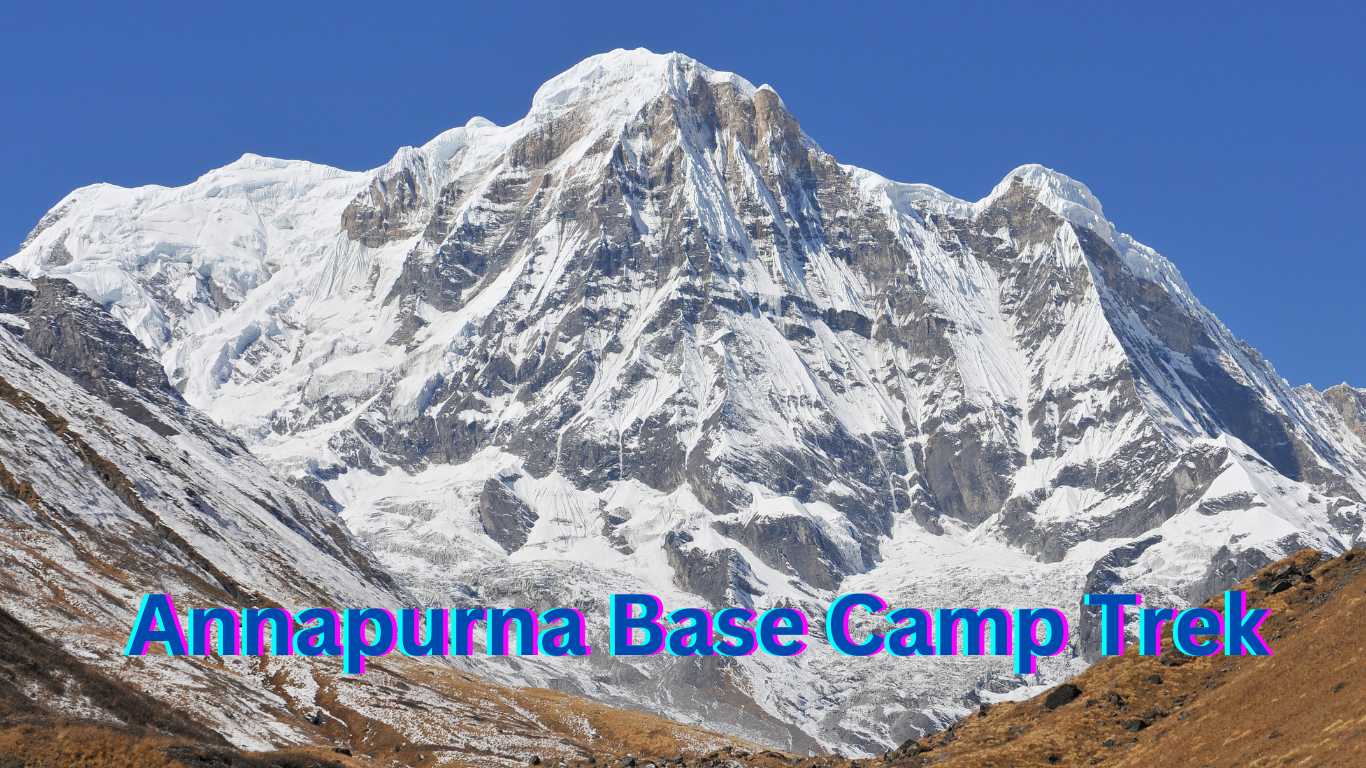Nestled within the heart of the majestic Himalayas, the Annapurna Base Camp Trek stands as a quintessential pilgrimage for trekkers and adventure enthusiasts from around the globe. The Annapurna region in Nepal, renowned for its breathtaking landscapes, rich cultural tapestry, and awe-inspiring mountain vistas, sets the stage for an expedition like no other. This trek often dubbed the “ABC Trek,” weaves through verdant valleys, picturesque villages, and rugged terrains, culminating in the astounding Annapurna Base Camp at an elevation of 4,130 meters (13,550 feet).
Each year, intrepid travelers embark on this journey, seeking to forge a connection with nature’s grandeur and immerse themselves in the vibrant local cultures that have thrived for generations in the shadow of these mighty peaks. In this article, we delve into the intricacies of the Annapurna Base Camp Trek, guiding you through the preparations, experiences, challenges, and cultural revelations that await those who dare to tread its path.
With its undeniable allure and the promise of unforgettable vistas, the Annapurna Base Camp Trek beckons all who yearn for adventure, self-discovery, and a rendezvous with some of the world’s most captivating landscapes. So, lace up your hiking boots, pack your sense of wonder, and join us as we explore the wonders of this iconic trekking odyssey.
Preparing for the Trek
Embarking on the Annapurna Base Camp Trek requires thoughtful preparation to ensure a safe, enjoyable, and fulfilling journey through the Himalayas. From physical readiness to obtaining the necessary permits, here’s a comprehensive guide to getting ready for the adventure of a lifetime.
Physical Fitness Requirements and Training
- Cardiovascular Endurance: The trek involves long hours of walking at varying altitudes. Building cardiovascular endurance through regular aerobic exercises like walking, jogging, cycling, or swimming will help you acclimate to the demands of the trail.
- Strength and Flexibility: Trekking often requires carrying a backpack and navigating uneven terrains. Incorporate strength training exercises, such as squats, lunges, and core workouts, to enhance your overall strength and stability. Flexibility exercises like yoga can improve your agility and prevent muscle strain.
- Altitude Conditioning: As you’ll be ascending to higher altitudes, it’s crucial to train at gradually increasing altitudes, if possible. This will help your body adapt to the reduced oxygen levels and minimize the risk of altitude sickness.
Required Permits and Documentation
- TIMS Card: Trekkers need a Trekkers’ Information Management System (TIMS) card, which helps monitor trekkers and ensures their safety. You can obtain this card through registered trekking agencies or the Nepal Tourism Board.
- Annapurna Conservation Area Permit (ACAP): Since the trek passes through the Annapurna Conservation Area, you’ll need an ACAP permit. This permit contributes to the conservation efforts of the region.
Essential Packing List for the Trek
- Clothing: Layering is essential to manage temperature changes. Pack moisture-wicking base layers, insulating mid-layers, a waterproof and windproof outer layer, comfortable hiking pants, gloves, and a warm hat.
- Footwear: Invest in sturdy, well-fitting hiking boots with good ankle support. Also, bring comfortable socks that wick moisture and prevent blisters.
- Gear: A sturdy backpack, trekking poles for stability, a reliable sleeping bag suitable for cold weather, and a headlamp are essential. Also, carry a refillable water bottle, a hat for sun protection, and a pair of sunglasses with UV protection.
- Personal Items: Sunscreen, lip balm, insect repellent, toiletries, a first aid kit (including altitude sickness medication), and any prescription medications.
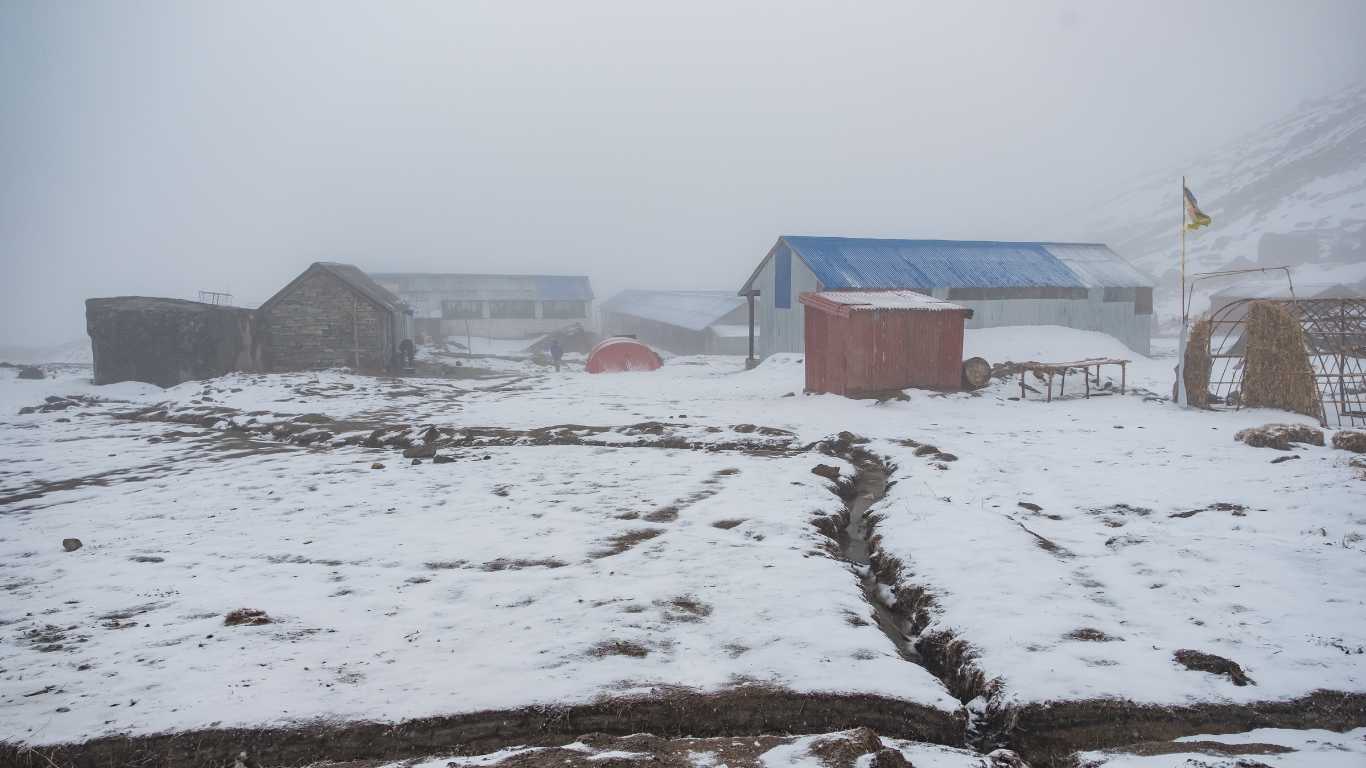
Choosing the Right Time for the Trek and Considering Weather Conditions
The Annapurna Base Camp Trek is accessible during two main trekking seasons:
- Spring (March to May): The weather is mild, and the rhododendron forests are in full bloom, creating a stunning visual landscape.
- Autumn (September to November): This is the most popular trekking season. The skies are clear, and the weather is stable, providing excellent visibility of the mountain ranges.
While these seasons offer the best conditions, the trek is possible year-round. However, the winter months (December to February) can be challenging due to heavy snowfall and sub-zero temperatures at higher altitudes.
By adequately preparing your body, acquiring the necessary permits, packing thoughtfully, and selecting the optimal trekking season, you’ll set the stage for a successful and memorable Annapurna Base Camp Trek. Remember, proper preparation enhances your safety and comfort, allowing you to fully embrace the awe-inspiring journey that lies ahead.
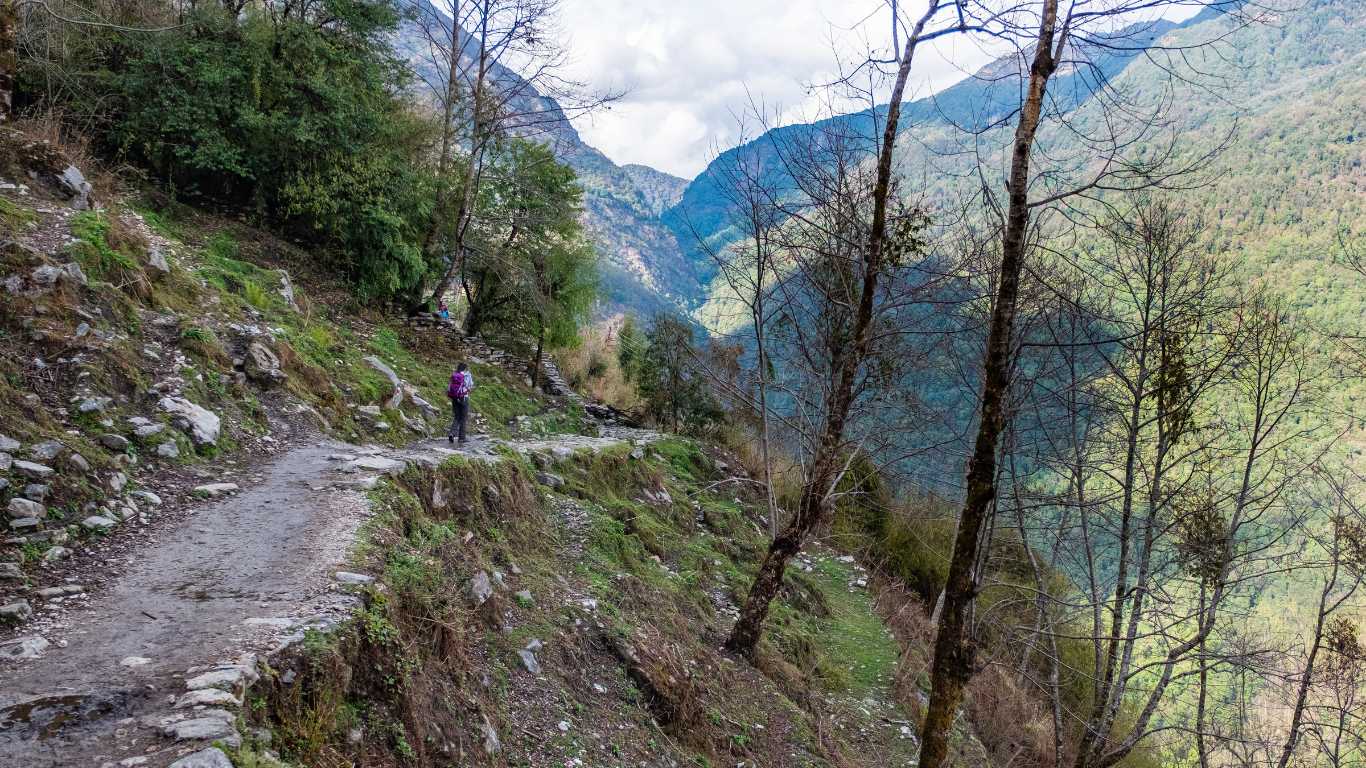
Itinerary and Route of the Annapurna Base Camp Trek
The Annapurna Base Camp Trek offers a mesmerizing journey through diverse landscapes, charming villages, and breathtaking mountain vistas. The following itinerary outlines the typical route taken during this iconic trek:
Day 1: Kathmandu to Pokhara
- Fly or drive from Kathmandu to Pokhara, the gateway to the Annapurna region.
- Explore Pokhara’s serene lakeside ambiance and prepare for the trek.
Day 2: Pokhara to Nayapul; Nayapul to Tikhedhunga
- Drive to Nayapul and commence the trek.
- Trek through picturesque terraced fields, cross the Modi Khola River and reach Tikhedhunga.
Day 3: Tikhedhunga to Ghorepani
- Ascend a steep stone staircase to Ulleri village.
- Pass through lush rhododendron forests and arrive at Ghorepani, known for its panoramic views.
Day 4: Ghorepani to Poon Hill (optional); Ghorepani to Tadapani
- Early morning hike to Poon Hill for a stunning sunrise over the Himalayas (optional).
- Continue to Tadapani through verdant forests, enjoying glimpses of the Annapurna and Dhaulagiri ranges.
Day 5: Tadapani to Chhomrong
- Descend through dense forests and terraced fields to Kimrong Khola.
- Ascend to Chhomrong, a Gurung village with breathtaking views of Annapurna South and Machapuchare.
Day 6: Chhomrong to Bamboo
- Descend to the Chhomrong Khola and ascend to Sinuwa.
- Follow a descent to Bamboo through a serene forested trail.
Day 7: Bamboo to Deurali
- Trek through lush bamboo and rhododendron forests.
- Pass through the Himalayan Hotel and reach Deurali, a hamlet situated in a gorge.
Day 8: Deurali to Annapurna Base Camp
- Traverse the breathtaking Modi Khola Valley, surrounded by towering cliffs.
- Reach the Annapurna Base Camp, a surreal amphitheater surrounded by Himalayan giants.
Day 9: Annapurna Base Camp to Bamboo
- Witness the sunrise over the majestic Annapurna massif.
- Begin your descent to Bamboo, retracing your steps through the lush forested trail.
Day 10: Bamboo to Jhinu Danda
- Continue descending to the Chhomrong Khola and ascend to Chhomrong.
- Trek to Jhinu Danda and relax in natural hot springs, a perfect respite for weary muscles.
Day 11: Jhinu Danda to Nayapul; Nayapul to Pokhara
- Descend to Nayapul and drive back to Pokhara.
- Celebrate the completion of your trek with a well-deserved meal and some relaxation.
Day 12: Pokhara to Kathmandu
- Return to Kathmandu by flight or drive.
- Reflect on your incredible journey through the Annapurna region.
Please note that this is a general itinerary and can be customized based on individual preferences, weather conditions, and the pace of the trekking group. The Annapurna Base Camp Trek offers a blend of natural beauty, cultural experiences, and physical challenges that make it an unforgettable adventure for trekkers seeking to immerse themselves in the Himalayan landscape.
Trekking Experience
Embarking on the Annapurna Base Camp Trek is a journey of discovery, both of the stunning natural beauty that surrounds you and of the inner strength you’ll uncover as you conquer challenges along the way. This section provides a detailed insight into the day-to-day trekking experience, showcasing the highlights, challenges, and cultural encounters that define this remarkable adventure.
Day-by-Day Account of the Trekking Journey
- Kathmandu to Pokhara: Begin your journey with a scenic flight or drive to Pokhara, Nepal’s second-largest city. Take in the serene ambiance of Phewa Lake and prepare for the upcoming adventure.
- Pokhara to Tikhedhunga: The trek commences at Nayapul. Traverse through charming villages, cross suspension bridges, and navigate uphill trails to reach Tikhedhunga.
- Ghorepani and Poon Hill: A steep ascent through lush rhododendron forests leads to Ghorepani. The optional pre-dawn hike to Poon Hill rewards you with a breathtaking sunrise over the Annapurna and Dhaulagiri ranges.
- Tadapani and Cultural Experiences: Walk through forests abundant with birdlife to Tadapani. Engage with local communities, embracing their customs and traditions.
- Chhomrong and Himalayan Views: Descend to Kimrong Khola and ascend to Chhomrong village. Enjoy stunning views of Annapurna South and Machapuchare.
- Bamboo and Forested Trails: Trek through bamboo and rhododendron forests, encountering the Himalayan Hotel en route to Bamboo.
- Deurali and the Modi Khola Valley: Continue through the enchanting Modi Khola Valley, surrounded by awe-inspiring cliffs, and reach Deurali.
- Annapurna Base Camp (ABC): The pinnacle of your journey. Ascend through glacial moraines to Annapurna Base Camp. Revel in the amphitheater of mountains, including Annapurna I (8,091m) and Machapuchare (6,993m).
- Sunrise at ABC and Descent: Greet the sunrise over the Himalayas before retracing your steps down to Bamboo.
- Jhinu Danda and Natural Hot Springs: Trek to Jhinu Danda, where you can soak in natural hot springs and unwind after your arduous journey.
- Completing the Trek: Descend to Nayapul and return to Pokhara. Celebrate your accomplishment and reflect on the transformative experience.
Detailed Description of Key Points of Interest
- Ulleri and the Stone-Paved Steps: The steep stone staircase leading to Ulleri provides an initial taste of the trek’s physical challenges while offering glimpses of the surrounding landscape.
- Ghorepani and the Poon Hill Sunrise: Ghorepani is a vibrant village with welcoming teahouses. The pre-dawn hike to Poon Hill presents a breathtaking panorama of the Himalayas illuminated by the rising sun.
- Ghandruk and Cultural Experiences: Immerse yourself in the rich Gurung culture of Ghandruk. Explore traditional architecture, interact with locals, and learn about their way of life.
- The Modi Khola Valley and Natural Beauty: The trek through the Modi Khola Valley introduces you to the diverse terrain of the Annapurna region, from dense forests to rocky landscapes.
- Annapurna Base Camp and Breathtaking Vistas: The ultimate highlight, the Annapurna Base Camp, rewards trekkers with a surreal amphitheater of snow-capped peaks and an overwhelming sense of accomplishment.
The Annapurna Base Camp Trek offers not only physical challenges and jaw-dropping scenery but also profound cultural experiences and opportunities for self-discovery. It’s a journey that will test your limits, forge connections with fellow trekkers, and leave an indelible mark on your memory.
Challenges and Safety
Trekking to the Annapurna Base Camp is a rewarding endeavor, but it also presents challenges that trekkers need to be aware of. Proper preparation, awareness, and adherence to safety guidelines are paramount to ensure a safe and enjoyable journey. This section discusses the challenges associated with the trek and provides insights into staying safe along the way.
Dealing with High Altitude and Altitude Sickness
- Altitude Acclimatization: The trek involves rapid gains in altitude, which can lead to altitude sickness. Allow your body time to acclimate by spending extra days at certain points on the trail, such as Ghorepani and Chhomrong.
- Recognizing Altitude Sickness: Symptoms of altitude sickness include headaches, nausea, dizziness, and shortness of breath. If symptoms worsen, it’s crucial to descend to a lower altitude immediately.
Safety Measures and Precautions
- Hiring Experienced Guides and Porters: Hiring a local guide and/or porter is highly recommended. They are familiar with the terrain, and weather conditions, and can provide valuable assistance in case of emergencies.
- Trail Conditions and Weather: Be prepared for changing weather conditions. Trails can become slippery, especially in monsoon season or after snowfall. Use trekking poles for stability and wear appropriate footwear.
- Hydration and Nutrition: Stay hydrated and maintain a balanced diet. Proper nutrition and hydration help your body cope with the physical demands of the trek and reduce the risk of altitude sickness.
- Travel Insurance: Make sure you have comprehensive travel insurance that covers medical emergencies, evacuations, and trip cancellations.
- Communication: Carry a mobile phone with local SIM card coverage for communication in case of emergencies. Some areas may have limited cell reception.
Importance of Acquiring First Aid Skills and Knowledge
- Basic First Aid Training: Consider taking a basic first aid course before embarking on the trek. Knowledge of basic first aid techniques can prove invaluable in case of minor injuries or medical issues.
- Carrying a First Aid Kit: Pack a well-equipped first aid kit containing essentials like bandages, antiseptics, pain relievers, and any personal medications.
- Health Check: Undergo a thorough health checkup before trekking, especially if you have pre-existing medical conditions. Inform your guide of any medical concerns.
Group Trekking and Responsible Behavior
- Trek in Groups: Whenever possible, trek in a group. This not only enhances safety but also provides camaraderie and support.
- Responsible Trekking Practices: Respect local customs, culture, and the environment. Stay on designated trails, avoid littering, and use reusable water bottles to minimize your impact.
Trekking to Annapurna Base Camp is a transformative experience, but ensuring your safety is paramount. By being aware of the challenges, following safety measures, and adopting responsible trekking practices, you’ll be better equipped to enjoy the journey while safeguarding your well-being.
Accommodation and Food
During the Annapurna Base Camp Trek, trekkers have the opportunity to experience the unique accommodations and cuisine that define the region. This section provides insights into the types of lodgings available along the trail and offers a glimpse into the local food culture.
Teahouse Accommodations
- Teahouse Lodges: Throughout the trek, you’ll find teahouse lodges that provide basic but comfortable accommodations. These lodges offer shared rooms with twin beds or bunk beds. Blankets are usually provided, but it’s advisable to carry your own sleeping bag for warmth.
- Facilities: Teahouses generally have communal dining areas, often heated with a central stove. Some lodges offer attached bathrooms, while others have shared bathroom facilities.
Local Cuisine and Dining Experience
- Traditional Nepali Food: Teahouses offer a variety of Nepali dishes that provide sustenance for trekkers. Dal Bhat, a traditional meal of rice, lentil soup, vegetables, and sometimes meat, is a staple and provides a balanced source of energy.
- International Options: You’ll also find a range of international dishes, including pasta, pizza, and sandwiches. However, keep in mind that these may not be as authentic as the local offerings.
- Hygiene Considerations: While dining, prioritize food safety and hygiene. Opt for freshly cooked meals and avoid raw foods or items that could potentially lead to stomach issues.
Staying Hydrated
- Safe Drinking Water: It’s crucial to stay hydrated during the trek. While bottled water is available, it’s better for the environment to use water purification methods, such as tablets or filters, to treat tap water.
- Hot Drinks: Warm beverages like tea and coffee are not only comforting but can also provide a sense of warmth in the chilly mountain environment.
Planning Dietary Needs
- Vegetarian and Dietary Restrictions: Teahouses are generally accommodating to dietary preferences, including vegetarian, vegan, and gluten-free options. However, it’s advisable to communicate your dietary needs clearly to the lodge staff.
- Snacks: Carry energy-rich snacks like nuts, energy bars, and dried fruits to keep your energy levels up between meals.
Experiencing local cuisine and lodgings is an integral part of the Annapurna Base Camp Trek. Embrace the opportunity to immerse yourself in the cultural and culinary landscape of the region while maintaining a balanced diet to fuel your trekking journey.
Permits and Regulations
Trekking in the Annapurna region requires obtaining specific permits and adhering to regulations to ensure environmental preservation and the safety of both trekkers and local communities. This section outlines the permits needed and provides insights into responsible trekking practices.
Necessary Permits
- Trekkers’ Information Management System (TIMS) Card: Managed by the Nepal Tourism Board, the TIMS card is essential for all trekkers. It helps authorities track trekkers and provide assistance in case of emergencies. There are two types of TIMS cards: Green (for independent trekkers) and Blue (for those trekking with a registered agency).
- Annapurna Conservation Area Permit (ACAP): The ACAP permit is vital as the trek passes through the Annapurna Conservation Area. The revenue from these permits contributes to the conservation and sustainable development of the region.
Responsible Trekking Practices
- Stay on Designated Trails: Stick to established trails to minimize soil erosion and avoid damaging the fragile mountain ecosystem.
- Litter Management: Carry out all non-biodegradable waste, such as plastic bottles and wrappers. Many tea houses have waste disposal facilities.
- Respect Local Customs and Culture: Be respectful of local communities, their traditions, and customs. Seek permission before taking photographs of people or their property.
- Minimize Impact: Use reusable water bottles and water purification methods to minimize the use of single-use plastic bottles. Conserve energy by turning off lights and heaters when not in use.
- Wildlife Conservation: Do not disturb or feed wildlife. Maintain a safe distance from animals encountered on the trail.
Safety Guidelines
- Registered Guides and Porters: Consider hiring a registered guide or porter. They have knowledge of the trail, and weather conditions, and can assist in emergencies.
- Health Precautions: Undergo a thorough medical checkup before trekking. Inform your guide of any medical conditions, allergies, or medications.
- Emergency Contact: Carry a fully charged mobile phone with local SIM card coverage for emergency communication.
- Altitude Acclimatization: Allow ample time for acclimatization. Ascend gradually to higher altitudes and be cautious of signs of altitude sickness.
- Travel Insurance: Ensure your travel insurance covers medical emergencies and evacuation.
Cultural Etiquette
- Greeting Locals: Greet locals with respect using the traditional “Namaste” gesture. Ask for permission before entering homes or taking photos.
- Dress Modestly: Dress modestly, especially in villages with conservative cultures. Revealing clothing may be considered disrespectful.
Environmental Awareness
- Carry Your Trash: Pack out all trash and waste, leaving the trails and campsites clean.
- Minimize Firewood Usage: Use kerosene or gas for cooking instead of firewood to reduce deforestation.
By obtaining the necessary permits and adhering to responsible trekking practices, you contribute to the preservation of the pristine Annapurna region and ensure a safe and positive experience for both yourself and future trekkers.
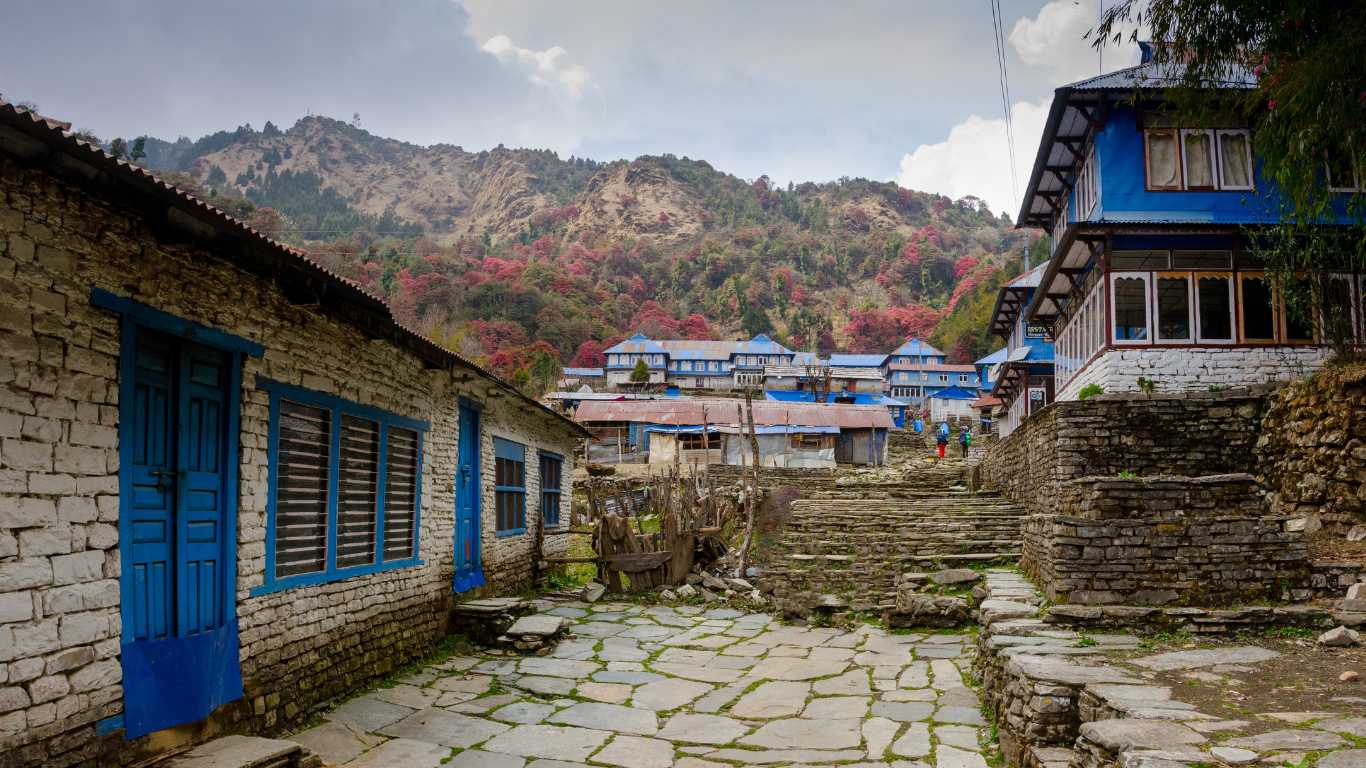
Cultural and Natural Highlights
The Annapurna Base Camp Trek isn’t just a journey through breathtaking landscapes; it’s also a cultural immersion into the lives of the local communities and an opportunity to witness the unique biodiversity of the region. This section delves into the rich cultural and natural highlights that await trekkers on this remarkable adventure.
Exploration of Local Flora and Fauna
- Rhododendron Forests: Trekking through dense rhododendron forests in spring offers a spectacular display of vibrant red, pink, and white blooms.
- Wildlife: Keep an eye out for various Himalayan wildlife, including langurs, Himalayan tahrs, and if you’re lucky, even the elusive snow leopard.
- Birdwatching: The region is a haven for bird enthusiasts, with species like the Danphe (Himalayan monal) and various species of pheasants and eagles.
Encounters with Diverse Ethnic Communities
- Gurung Culture: Interact with the indigenous Gurung community, known for their warm hospitality and distinct traditions. Explore Gurung villages like Ghandruk and learn about their way of life.
- Cultural Insights: Engage in cultural exchanges, witnessing traditional dance performances and rituals that showcase the deep-rooted traditions of the people.
- Homestays: In some areas, you have the opportunity to experience a homestay, allowing you to immerse yourself in the daily life of local families.
Monasteries, Shrines, and Cultural Sites
- Tengboche Monastery: Although not directly on the Annapurna Base Camp Trek, Tengboche Monastery in the Everest region is a renowned site and can be visited as an extension. It offers insight into Tibetan Buddhism and stunning views of Ama Dablam.
- Gurung Museum: In Ghandruk, the Gurung Museum showcases traditional artifacts, clothing, and historical items that offer a glimpse into the Gurung culture.
- Hot Springs: Enjoy a rejuvenating dip in natural hot springs at Jhinu Danda, a perfect way to relax and soothe your muscles after days of trekking.
Ethereal Mountain Vistas
- Poon Hill Sunrise: The iconic sunrise from Poon Hill presents a panoramic view of the Annapurna and Dhaulagiri ranges, illuminated by the first rays of dawn.
- Annapurna Base Camp: The final destination of the trek offers a surreal amphitheater of peaks, with Annapurna I and Machapuchare dominating the scenery.
- Majestic Peaks: Throughout the trek, you’ll be surrounded by the Himalayan giants, offering awe-inspiring vistas that stay etched in your memory.
The Annapurna Base Camp Trek is not just a physical journey; it’s an opportunity to connect with the natural world, appreciate the diversity of human cultures, and be humbled by the grandeur of the mountains. These cultural and natural highlights add depth and richness to an already unforgettable experience.
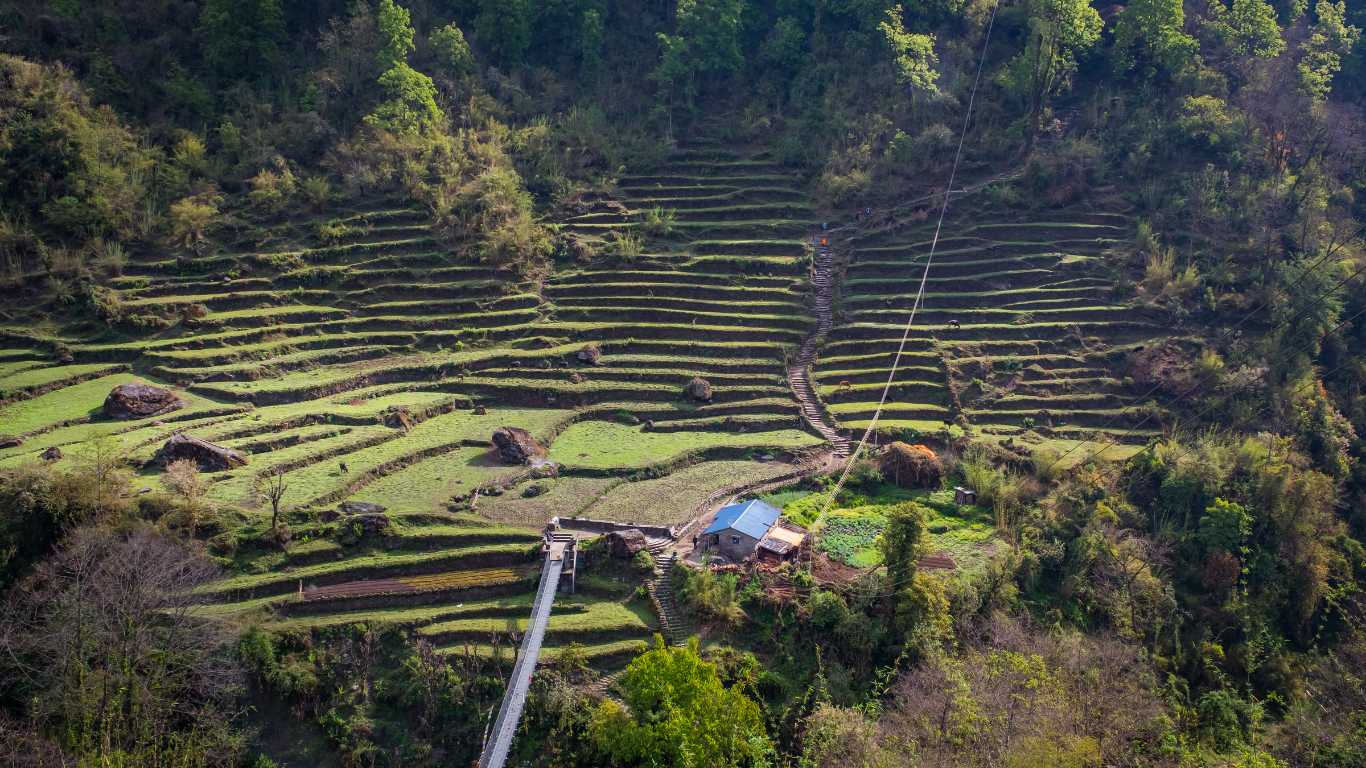
Tips for a Successful Trek
Embarking on the Annapurna Base Camp Trek is a thrilling adventure, but proper planning and preparation are essential for a successful and enjoyable experience. Here are some invaluable tips to make the most of your journey through the Himalayas.
Physical and Mental Preparation
- Training: Build your cardiovascular endurance, strength, and flexibility through regular exercise and hiking practice.
- Mental Resilience: Be mentally prepared for challenging moments. Trekking at high altitudes can be physically demanding, but maintaining a positive mindset will keep you motivated.
- Altitude Acclimatization: Allow for gradual altitude gains and schedule acclimatization days to minimize the risk of altitude sickness.
Gear and Packing
- Pack Light: Keep your backpack as light as possible. Only pack essentials and consider hiring a porter to carry some of your load.
- Layer Clothing: Dress in layers to manage temperature changes. Invest in quality gear, especially footwear, to ensure comfort during the trek.
- Don’t Forget Snacks: Carry energy-rich snacks for quick energy boosts between meals.
Health and Hygiene
- Stay Hydrated: Drink plenty of fluids to prevent dehydration. Proper hydration helps with acclimatization and energy levels.
- Sanitation: Carry hand sanitizer and follow proper hygiene practices to prevent illness.
- Altitude Sickness: Know the symptoms of altitude sickness and be prepared to descend if symptoms worsen.
Safety Measures
- Travel Insurance: Have comprehensive travel insurance that covers medical emergencies, evacuations, and trip cancellations.
- Emergency Contacts: Keep a list of emergency contacts, including local authorities, your trekking agency, and your country’s embassy.
- Stay Informed: Stay updated on weather conditions and trail information through your guide or locals.
Respect Local Culture and Environment
- Cultural Etiquette: Respect local customs, dress codes, and traditions. Ask for permission before taking photographs of people.
- Environmental Responsibility: Follow “Leave No Trace” principles and avoid single-use plastics. Minimize your impact on the environment.
- Community Interaction: Engage with local communities respectfully and support local businesses by purchasing souvenirs and meals.
Listen to Your Body
- Know Your Limits: Don’t push yourself too hard. Listen to your body and be willing to adjust your itinerary if needed.
- Rest and Recovery: Ensure you get enough sleep and rest during the trek. Proper recovery contributes to your overall well-being.
- Stay Positive: Maintain a positive attitude and enjoy the journey. Embrace the challenges and relish the rewards.
Trekking to Annapurna Base Camp is a life-enriching experience that combines natural beauty, cultural encounters, and personal growth. By following these tips and embracing the adventure with an open heart, you’ll create memories that will stay with you for a lifetime.
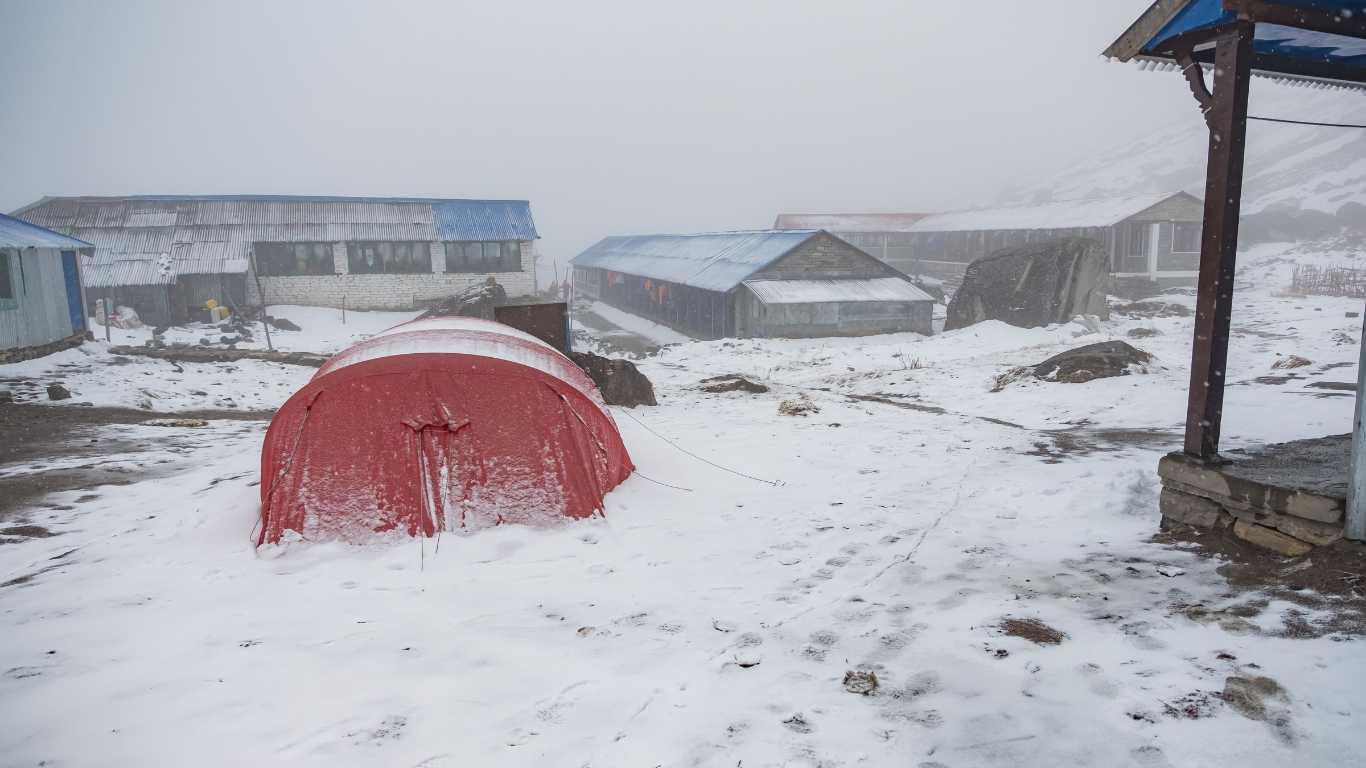
Best Time to Trek to Annapurna Base Camp
Choosing the right time to embark on the Annapurna Base Camp Trek is crucial for a safe and enjoyable experience. The region experiences distinct seasons that impact weather conditions, visibility, and overall trekking conditions. The two primary trekking seasons are spring and autumn, both offering their own unique advantages.
Spring (March to May):
Advantages:
- Flower Blooms: The trek is adorned with colorful rhododendron blossoms, creating a stunning visual spectacle.
- Mild Weather: Spring offers pleasant temperatures during the day and relatively mild nights.
- Clear Views: The skies are often clear, providing excellent visibility of the surrounding mountain ranges.
Considerations:
- Crowds: Spring is a popular trekking season, so the trails and teahouses might be busier.
- Permits: Make sure to obtain necessary permits well in advance due to the high demand.
Autumn (September to November):
Advantages:
- Stable Weather: Autumn is characterized by stable weather, clear skies, and comfortable temperatures.
- Less Rainfall: The chances of rain are minimal, reducing the risk of slippery trails.
- Clear Mountain Views: Excellent visibility of the Annapurna and Dhaulagiri ranges, making it a photographer’s paradise.
Considerations:
- Crowds: Like spring, autumn is a popular season, so trails might be crowded, particularly around popular viewpoints.
- Preparation: Due to its popularity, accommodations can fill up quickly. It’s advisable to book teahouses in advance.
Other Seasons:
Summer (June to August): This is the monsoon season, characterized by heavy rainfall, muddy trails, and leeches. While trekking is possible, it’s more challenging due to poor visibility and slippery paths.
Winter (December to February): Winter brings cold temperatures and snowfall to higher altitudes, making the trek more challenging. Some lodges at higher elevations might be closed, and the trail can be icy.
Ultimately, the best time to trek to Annapurna Base Camp depends on your preferences, priorities, and tolerance for different weather conditions. Spring and autumn offer the best overall trekking experience, with clear skies, moderate temperatures, and breathtaking vistas. Regardless of the season you choose, proper preparation and a positive mindset are key to making the most of this incredible journey.
Annapurna Base Camp Trek Cost
The cost of the Annapurna Base Camp trek can vary depending on several factors, including the duration of the trek, the type of accommodations you choose, the services of guides and porters, and your personal preferences. Here’s a general breakdown of potential costs:
Permits: The cost of permits includes the Annapurna Conservation Area Permit (ACAP) and the Trekkers’ Information Management System (TIMS) card. These fees vary for foreigners and locals.
Guide and Porter: Hiring a local guide and/or porter is recommended for safety and convenience. Guides provide insights into the local culture and environment. Porters carry your heavy backpack, allowing you to enjoy the trek without the burden.
Accommodation: Accommodation costs vary based on the type of lodges you choose. Basic tea houses are more budget-friendly, while more comfortable accommodations are available at a higher cost.
Food and Drinks
The cost of meals and drinks depends on your dietary preferences. Expect higher prices at higher altitudes due to the remote location.
Transportation: The cost of transportation to and from the trailhead (Nayapul or Phedi) from cities like Pokhara is an additional expense.
Equipment and Gear: If you don’t have appropriate trekking gear, you might need to rent or purchase items like sleeping bags, trekking poles, and jackets.
Miscellaneous Expenses: This includes expenses for tips, snacks, souvenirs, and any unforeseen costs.
Average Range: On average, the total cost for the Annapurna Base Camp trek can range from $700 to $1500 USD per person. This estimate covers a 10-14 day trek with moderate accommodations, a guide, porter, permits, food, and transportation.
It’s important to note that these estimates are rough averages and can vary based on individual choices and preferences. It’s recommended to research and plan in advance, considering the services you want, and budgeting for potential extra expenses. Additionally, local economic conditions and inflation can influence the costs over time.
Conclusion
Embarking on the Annapurna Base Camp Trek is a journey of a lifetime, weaving through diverse landscapes, cultural encounters, and awe-inspiring mountain vistas. Whether you trek during the vibrant blooms of spring or the clear skies of autumn, the experience leaves an indelible mark. From the challenging ascents to the tranquil villages, each step brings you closer to the beauty of nature and the warmth of local communities. With proper preparation, respect for the environment, and an open heart, this adventure offers not just a physical journey, but a transformative exploration of yourself and the captivating world around you.
Frequently Asked Questions About Annapurna Base Camp Trek
How long does it take to complete the Annapurna Base Camp Trek?
The Annapurna Base Camp Trek typically takes around 7 to 12 days to complete, depending on the specific route chosen and your walking pace. Most trekkers opt for an itinerary of about 9 to 11 days, allowing for acclimatization and enjoyment of the stunning landscapes along the way.
What is the best time to do the Annapurna Base Camp Trek?
The best time to undertake the Annapurna Base Camp Trek is during the spring (March to May) and autumn (September to November) seasons. These months offer stable weather, clear skies, and comfortable temperatures for trekking. The monsoon season (June to August) is best avoided due to heavy rainfall and potential landslides.
Do I need permits for the Annapurna Base Camp Trek?
Yes, you will need permits to trek to Annapurna Base Camp. The two main permits required are the Annapurna Conservation Area Permit (ACAP) and the Trekkers’ Information Management System (TIMS) card. These permits help fund conservation efforts and provide essential trekker information to authorities.
Is the Annapurna Base Camp Trek physically challenging?
The trek to Annapurna Base Camp is considered moderately challenging. While it doesn’t involve technical climbing, you will encounter steep ascents and descents, uneven terrain, and high altitude. It’s essential to be in good physical condition and allow time for acclimatization to minimize the risk of altitude sickness.
What is the accommodation like during the trek?
Along the Annapurna Base Camp Trek, you’ll find a range of accommodation options, from basic teahouses and guesthouses to more comfortable lodges. The quality of facilities can vary, but most provide simple rooms with basic amenities like a bed and shared bathrooms. During peak trekking seasons, it’s a good idea to book your accommodation in advance.

